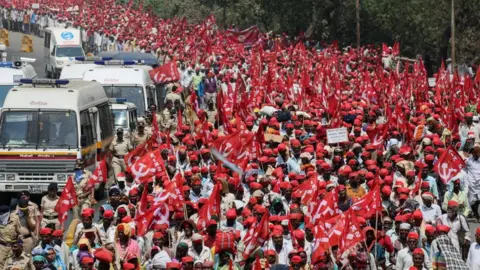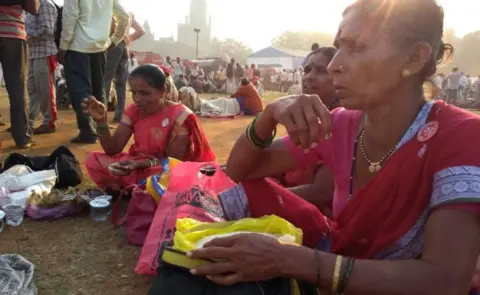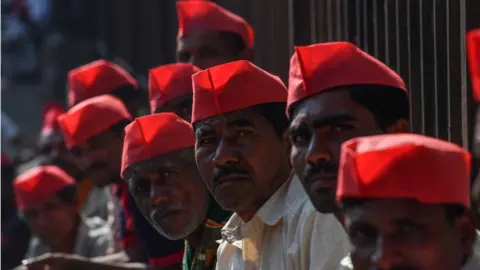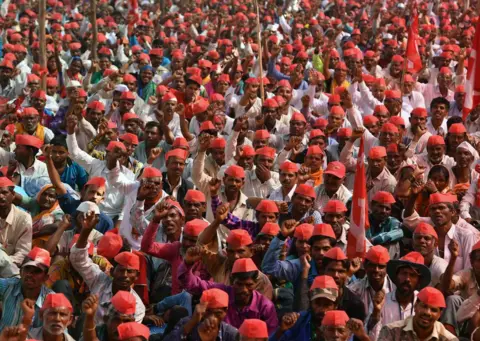Thousands of Indian farmers end protest after talks with government
 EPA
EPAFarmers in the western Indian state of Maharashtra have ended their protest over loan waivers, prices and land rights after meeting state ministers.
Ministers said disputes still pending over tribal farmers' ownership of land would be settled within six months.
They also said the government would expand the loan-waiver scheme to benefit all farmers.
The farmers had said the government was yet to implement the waiver it had promised them last year.
Tens of thousands of protesters, including children, women and the elderly, had converged in the state capital, Mumbai, after walking 167km (103 miles) from Nashik district.
It took them six days to reach Azad Maidan - a ground that is frequently used for protests and concerts - in the early hours of Monday.
The protest was led by a national farmers' organisation affiliated to the Communist Party of India (Marxist).
Why were they protesting?
Apart from the loan waivers, farmers said they wanted to be paid at least one-and-a-half times the cost of their crops. The government sets prices for farming in India and procures crops from farmers to incentivise production and ensure income support.
The protesters also wanted tribal farmers, who mainly cultivate in forests, to be allowed to own land.
 BBC Marathi
BBC MarathiFarmers' leader Vijay Javandhia told BBC Marathi that "agricultural income has swiftly declined in the country".
"Income in cotton, grains and pulses is declining day by day. That's why the rural economy is gradually running out of money," he said.
Sakhubai, a 65-year-old woman farmer from Nashik, said: "We need our land and this is our prime demand.
"I have injured my feet due to excessive walking, but I will continue to protest until our demands are met."
 Getty Images
Getty ImagesDharmraj Shinde, one of the organisers of the march, said "we are fighting for our land".
"The government should give us ownership because it's our right as tribal people," he said.
Senior journalist P Sainath, who has covered farming issues for decades, told BBC Marathi that the government must listen.
"Consider how difficult it is for tribals who are fighting for forest land rights, consider how difficult it is for extremely poor women who are around 60 or 70 years to march from Nashik to Mumbai in such a hot climate," he said.
"And they are away from their work for five days."

'We want what we were promised' - Subhash Kalu Gangode

We are here to protest against the unfair policies adopted by the state government of Maharashtra with respect to farmers.
I had borrowed 40,000 rupees ($615; £444) under a "crop loan" (loans for farmers to buy fertilisers, seeds and other materials required for farming).
The state government announced in June 2017 that it was waiving loans to help farmers in debt. I completed all the paperwork that was required to get the waiver.
But it is yet to come into effect. I have checked with the bank several times.
I know I am eligible because the waiver applied to all loans up to 150,000 rupees.

What are the issues Indian farmers face?
For decades now, farming in India has been blighted by drought, a depleting water table, declining productivity and lack of modernisation.
Half of India's population works in farms, but farming contributes only 15% to the country's GDP. Put simply, farms employ a lot of people but produce too little.
 Getty Images
Getty ImagesCrop failures also trigger farm suicides with alarming frequency.
Indian farmers also struggle with surplus harvests because the country lacks adequate food storage and processing capacity.
